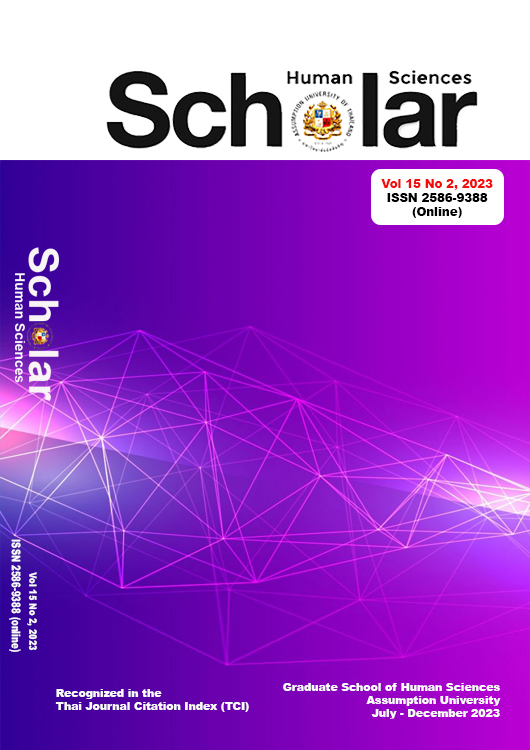Behavioral Intention to Use Mobile Reading Apps Among Female Students in Chengdu, China
DOI:
https://doi.org/10.14456/shserj.2023.32Keywords:
Mobile Apps, Satisfaction, Trust, Behavioral intention, ChinaAbstract
Purpose: This paper analyzes the factors affecting behavioral intentions of female students in Chengdu, China, to use and purchase mobile reading applications. The conceptual framework proposes the causal relationship among perceived value, satisfaction, service quality, trust, social influence, perceived usefulness, perceived ease of use and behavioral intention. Research design, data, and methodology: In this study, 840 female students were investigated by using judgmental, stratified random, and convenience sampling. The primary data collection tool was a questionnaire. Statistical software was used for data analysis, using confirmatory factor analysis (CFA) and structural equation model (SEM). The validity and reliability test were accounted to verify the data. Results: Perceived value and service quality significantly impact satisfaction towards trust and behavioral intention. Perceived ease of use has a significant impact on perceived usefulness. Furthermore, behavioral intention is significantly impacted by social influence and perceived usefulness but not by perceived ease of use. Conclusion: Software developers should pay attention to consumer needs to be able to attract college students with high-quality content and ensure payment security. To sum up, the findings are helpful for mobile reading developers to enhance the behavioral intention to purchase and use the mobile reading apps in China.
References
Athanassopoulos, A., Gounaris, S., & Stathakopoulos, V. (2001). Behavioural responses to customer satisfaction: an empirical study. European Journal of Marketing, 35(5/6), 687-707. https://doi.org/10.1108/03090560110388169
Benjangjaru, B., & Vongurai, R. (2018). Behavioral intention of Bangkokians to adopt mobile payment services by type of users. AU-GSB E-JOURNAL, 11(1), 34-46.
Bollen, K. A., & Noble, M. D. (2011). Structural equation models and the quantification of behavior. Proceedings of the National Academy of Sciences, 108(3), 15639-15646. https://doi.org/10.1073/pnas.1010661108
Carlson, J., & O'Cass, A. (2010). Exploring the relationships between e-service quality, satisfaction, attitudes and behaviours in content-driven e-service web sites. Journal of Services Marketing, 24(2), 112-127. https://doi.org/10.1108/0887604101103109
Çelik, H. (2008). What determines Turkish customers' acceptance of internet banking?. International Journal of Bank Marketing, 26(5), 353-370. https://doi.org/10.1108/02652320810894406
Chatterjee, S., Shainesh, G., & Sravanan, C. N. S. (2018). Does intention translate into action? Investigating the impact of loyalty intention on future usage. Journal of Indian Business Research, 10(2), 151-169.
https://doi.org/10.1108/jibr-11-2017-0213
Chen, Z., & Dubinsky, A. J. (2003). A conceptual model of perceived customer value in e-commerce: A preliminary investigation. Psychology and Marketing, 20(4), 323-347. https://doi.org/10.1002/mar.10076
Collier, J. E., & Bienstock, C. C. (2006). Measuring Service Quality in E-Retailing. Journal of Service Research, 8(3), 260-275. https://doi.org/10.1177/1094670505278867
Costabile, M., Raimondo, M. A., & Miceli, G. (2002). A dynamic model of customer loyalty. Marketing Academy, 28-31.
Cronin, J. J., & Taylor, S. A. (1992). Measuring Service Quality: A Reexamination and Extension. Journal of Marketing, 56(3), 55. https://doi.org/10.2307/1252296
Davis, F. D. (1989). Perceived Usefulness, Perceived Ease of Use, and User Acceptance of Information Technology. MIS Quarterly, 13(3), 319. https://doi.org/10.2307/249008
Etikan, I., & Bala, K. (2017). Sampling and sampling methods. Biometrics & Biostatistics International Journal, 5(6), 215-217.
Fishbein, M., & Ajzen, I. (1975). Belief, Attitude, Intention and Behaviour (1st ed.). An Introduction to Theory and Research.
Fornell, C. (1992). A National Customer Satisfaction Barometer: The Swedish Experience. Journal of Marketing, 56(1), 6-21. https://doi.org/10.1177/002224299205600103
Fornell, C., Johnson, M. D., Anderson, E. W., Cha, J., & Bryant, B. E. (1996). The American Customer Satisfaction Index: Nature, Purpose, and Findings. Journal of Marketing, 60(4), 7-18. https://doi.org/10.1177/002224299606000403
Gallarza, M. G., Gil-Saura, I., & Holbrook, M. B. (2011). The value of value: Further excursions on the meaning and role of customer value. Journal of Consumer Behaviour, 10(4), 179-191. https://doi.org/10.1002/cb.328
Gefen, D., Karahanna, E., & Straub, D. W. (2003). Trust and TAM in Online Shopping: An Integrated Model. MIS Quarterly, 27(1), 51. https://doi.org/10.2307/30036519
Gerpott, T. J., Rams, W., & Schindler, A. (2001). Customer retention, loyalty, and satisfaction in the German mobile cellular telecommunications market. Telecommunications Policy, 25(4), 249-269. https://doi.org/10.1016/s0308-5961(00)00097-5
Giovanis, A. N., Binioris, S., & Polychronopoulos, G. (2012). An extension of TAM model with IDT and security/privacy risk in the adoption of internet banking services in Greece. EuroMed Journal of Business, 7(1), 24-53.
https://doi.org/10.1108/14502191211225365
Guoming, Y. (2020). How People Use Media: The Influence of User's Social Characteristics - "Investigation on the Use of Media and Media Outlook of the Whole People". Journal of Liaoning University, 3(2), 48-51.
Hair, J. F., Black, W. C., Babin, B. J., Anderson, R. E., & Tatham, L. R. (2006). Multivariant Data Analysis (6th ed.). Pearson International Edition.
Haksever, C., Render, B., Russel, R. S., & Murdick, R. G. (2000). Service Management and Operations (2nd ed.). Prentice Hall.
Hsin Chang, H., & Wang, H.-W. (2011). The moderating effect of customer perceived value on online shopping behaviour. Online Information Review, 35(3), 333-359. https://doi.org/10.1108/14684521111151414
Hunt, H. K. (1977). Conceptualization and Measurement of Consumer Satisfaction and Dissatisfaction. Marketing Science Institute, 14(1), 455-488.
Jimenez, N., San-Martin, S., & Azuela, J. I. (2016). Trust and satisfaction: the keys to client loyalty in mobile commerce. Academia Revista Latinoamericana de Administración, 29(4), 486-510. https://doi.org/10.1108/arla-12-2014-0213
Juran, J. M. (1988). Juran on Planning for Quality. Free Press.
Kaur, S., & Arora, S. (2020). Role of perceived risk in online banking and its impact on behavioral intention: trust as a moderator. Journal of Asia Business Studies, 15(1), 1-30. https://doi.org/10.1108/jabs-08-2019-0252
Khalilzadeh, J., Ozturk, A. B., & Bilgihan, A. (2017). Security-related factors in extended UTAUT model for NFC based mobile payment in the restaurant industry. Computers in Human Behavior, 70, 460-474. https://doi.org/10.1016/j.chb.2017.01.001
Kotler, P. (2000). Marketing management: Analyzing consumer marketing and Buyer behavior (1st ed.). Prentice Hall
Ladhari, R. (2008). Alternative measures of service quality: a review. Managing Service Quality: An International Journal, 18(1), 65-86. https://doi.org/10.1108/09604520810842849
Lai, J.-Y., & Chang, C.-Y. (2011). User attitudes toward dedicated e-book readers for reading: The effects of convenience, compatibility and media richness. Online Information Review, 35(4), 558-580. https://doi.org/10.1108/14684521111161936
Lee, M.-C. (2009). Factors influencing the adoption of internet banking: An integration of TAM and TPB with perceived risk and perceived benefit. Electronic Commerce Research and Applications, 8(3), 130-141. https://doi.org/10.1016/j.elerap.2008.11.006
Leisen, B., & Hyman, M. R. (2004). Antecedents and consequences of trust in a service provider. Journal of Business Research, 57(9), 990-999. https://doi.org/10.1016/s0148-2963(02)00343-0
Liu, Y., Li, H., Kostakos, V., Goncalves, J., Hosio, S., & Hu, F. (2014). An empirical investigation of mobile government adoption in rural China: A case study in Zhejiang province. Government Information Quarterly, 31(3), 432-442. https://doi.org/10.1016/j.giq.2014.02.008
Liu, Z., & Huang, X. (2016). Reading on the move: A study of reading behavior of undergraduate smartphone users in China. Library & Information Science Research, 38(3), 235-242. https://doi.org/10.1016/j.lisr.2016.08.007
Loureiro, S. M. C., & González, F. J. M. (2008). The Importance of Quality, Satisfaction, Trust, and Image in Relation to Rural Tourist Loyalty. Journal of Travel & Tourism Marketing, 25(2), 117-136. https://doi.org/10.1080/10548400802402321
Malaquias, R. F., & Hwang, Y. (2016). An empirical study on trust in mobile banking: A developing country perspective. Computers in Human Behavior, 54, 453-461. https://doi.org/10.1016/j.chb.2015.08.039
Moorman, C., Deshpande, R., & Zaltman, G. (1993). Factors Affecting Trust in Market Research Relationships. Journal of Marketing, 57(1), 81. https://doi.org/10.2307/1252059
Morgan, R. M., & Hunt, S. D. (1994). The Commitment-Trust Theory of Relationship Marketing. Journal of Marketing, 58(3), 20-38. https://doi.org/10.1177/002224299405800302
Nikou, S., & Bouwman, H. (2014). Ubiquitous use of mobile social network services. Telematics and Informatics, 31(3), 422-433. https://doi.org/10.1016/j.tele.2013.11.002
Nysveen, H., Pedersen, P. E., Thorbjørnsen, H., & Berthon, P. (2005). Mobilizing the Brand: The Effects of Mobile Services on Brand Relationships and Main Channel Use. Journal of Service Research, 7(3), 257-276. https://doi.org/10.1177/1094670504271151
Oliver, R. L. (1980). A Cognitive Model of the Antecedents and Consequences of Satisfaction Decisions. Journal of Marketing Research, 17(4), 460-469. https://doi.org/10.1177/002224378001700405
Oliver, R. L. (1997). Satisfaction: A Behavioural Perspective on the Customer (2nd ed.). McGraw-Hill Companies
Pedroso, V., Navarro, M. V., Fleites, B. I., & Sosa Solis, E. C. (2016). Feeding systems with foliage of Morus alba and sugar cane stalks for fattening rabbits. Feedipedia, 17(12), 1-7.
Phonthanukitithaworn, C., Sellitto, C., & Fong, M. W. L. (2016). An investigation of mobile payment (m-payment) services in Thailand. Asia-Pacific Journal of Business Administration, 8(1), 37-54. https://doi.org/10.1108/apjba-10-2014-0119
Sandra, K., Vandenheede, I., & Sandra, P. (2014). Modern chromatographic and mass spectrometric techniques for protein biopharmaceutical characterization. Journal of Chromatography A, 1335, 81-103.
https://doi.org/10.1016/j.chroma.2013.11.057
Santos, J. (2003). E-service quality: a model of virtual service quality dimensions. Managing Service Quality: An International Journal, 13(3), 233-246. https://doi.org/10.1108/09604520310476490
Sica, C., & Ghisi, M. (2007). The Italian Versions of the Beck Anxiety Inventory and the Beck Depression Inventory-II: Psychometric Properties and Discriminant Power. In M.A. Lange. Leading - Edge Psychological Tests and Testing Research, 2(3), 27-50.
Singh, S., Sahni, M. M., & Kovid, R. K. (2020). What drives FinTech adoption? A multi-method evaluation using an adapted technology acceptance model. Management Decision, 58(8), 1675-1697. https://doi.org/10.1108/md-09-2019-1318
Sirdeshmukh, D. (2002). Consumer Trust, Value, and Loyalty in Relational Exchanges. Journal of Marketing, 66, 15-37. https://doi.org/10.1509/jmkg.66.1.15.18449
Tarhini, A., El-Masri, M., Ali, M., & Serrano, A. (2016). Extending the UTAUT model to understand the customers' acceptance and use of internet banking in Lebanon: A structural equation modeling approach. Information Technology & People, 29(4), 830-849. https://doi.org/10.1108/itp-02-2014-0034
Thakur, R., & Srivastava, M. (2014). Adoption readiness, personal innovativeness, perceived risk and usage intention across customer groups for mobile payment services in India. Internet Research, 24(3), 369-392. https://doi.org/10.1108/intr-12-2012-0244
Ulaga, W., & Eggert, A. (2006). Value-Based Differentiation in Business Relationships: Gaining and Sustaining Key Supplier Status. Journal of Marketing, 70(1), 119-136. https://doi.org/10.1509/jmkg.70.1.119.qxd
Venkatesh, V., & Davis, F. D. (2000). A Theoretical Extension of the Technology Acceptance Model: Four Longitudinal Field Studies. Management Science, 46(2), 186-204. https://doi.org/10.1287/mnsc.46.2.186.11926
Venkatesh, V., Brown, S. A., Maruping, L. M., & Bala, H. (2008). Predicting Different Conceptualizations of System Use: The Competing Roles of Behavioral Intention, Facilitating Conditions, and Behavioral Expectation. MIS Quarterly, 32(3), 483. https://doi.org/10.2307/25148853
Venkatesh, V., Morris, M. G., Davis, G. B., & Davis, F. D. (2003). User acceptance of information technology: toward a unified view. MIS Quarterly, 27(3), 425-478.
Xianglian, M. (2021). Major engineering geological problems and countermeasures along traffic corridor. Journal of Engineering Geology, 29(2), 307-325.
Yanfeng, S. (2017). Bibliometrics and knowledge mapping analysis of domestic paid digital reading research -- based on CNKI2002-2018 data. Library Science Research, 15, 2-5.
Yu, C. S. (2012). Factors affecting individuals to adopt mobile banking: empirical evidence from the UTAUT model, Journal of Electronic Commerce Research, 13(2), 104-121.
Yuce, A., Tan, N., & Atherton, D. P. (2019). Limit cycles in relay systems with fractional order plants. Transactions of the Institute of Measurement and Control, 41(15), 4424-4435. https://doi.org/10.1177/0142331219860302
Zeithaml, V. A. (1988). Consumer Perceptions of Price, Quality, and Value: A Means-End Model and Synthesis of Evidence. Journal of Marketing, 52(3), 2-22. https://doi.org/10.1177/002224298805200302
Zeithaml, V. A., & Bitner, M. J. (1996). Customer Expectations of Service’s-Services Marketing. McGraw Hill.
Zhang, L., & Ma, W. (2011). Correlation analysis between users' educational level and mobile reading behavior. Library Hi Tech, 29(3), 424-435. https://doi.org/10.1108/07378831111174396
Downloads
Published
How to Cite
Issue
Section
License
The submitting author warrants that the submission is original and that she/he is the author of the submission together with the named co-authors; to the extend the submission incorporates text passages, figures, data, or other material from the work of others, the submitting author has obtained any necessary permission.
Articles in this journal are published under the Creative Commons Attribution License (CC-BY What does this mean?). This is to get more legal certainty about what readers can do with published articles, and thus a wider dissemination and archiving, which in turn makes publishing with this journal more valuable for you, the authors.




